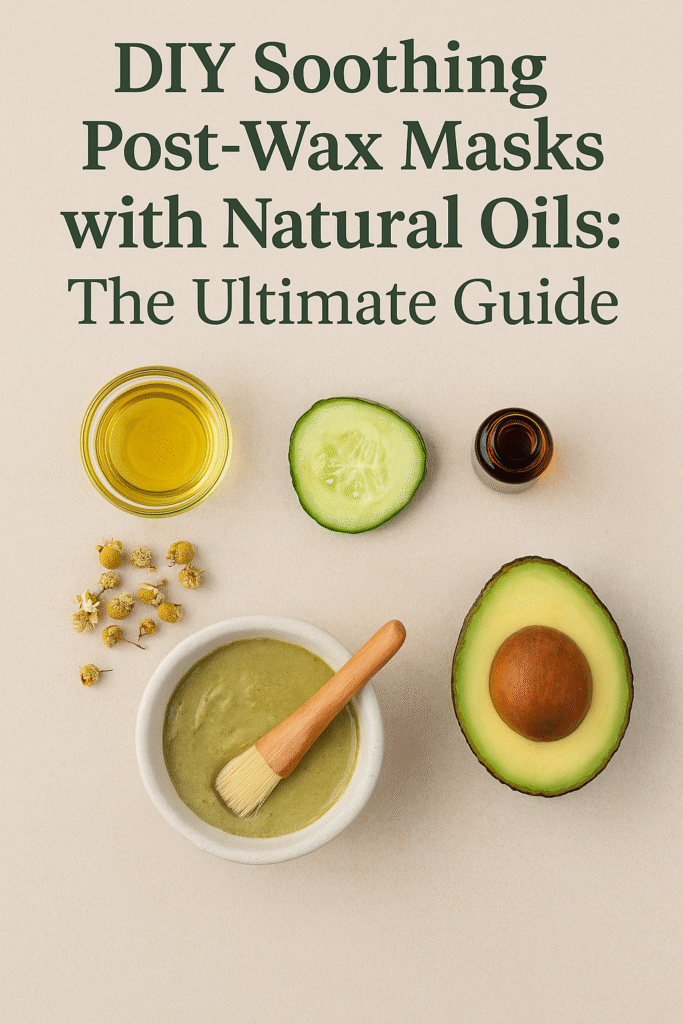Give your skin the tender loving care it deserves after waxing by whipping up simple, all-natural masks that calm redness, lock in moisture, and prevent bumps. In this deep-dive, we’ll explore why post-wax care is crucial, unveil the top calming oils, share five easy DIY mask recipes, and arm you with expert application tips. Follow along to turn every at-home wax into a spa-level experience.
Why Post-Wax Care Matters
Waxing removes hair by the root, but it also stretches and temporarily injures the uppermost skin layers. Without immediate soothing, you risk:
- Acute redness and inflammation
- Painful ingrown hairs and bumps
- Dryness, peeling, or even micro-tears
A targeted mask rich in natural oils can rapidly rebuild the skin barrier, calm irritation, and keep your complexion smooth between waxing sessions.
Benefits of Natural Oils for Waxed Skin
Natural oils bring a blend of antioxidants, essential fatty acids, and vitamins that synthetic creams often lack. Key benefits include:
- Deep hydration: Oils like jojoba and avocado mimic skin’s own lipids, sealing in moisture without clogging pores.
- Anti-inflammatory action: Chamomile, lavender, and rosehip oils reduce histamine responses, quelling redness and itch.
- Antimicrobial protection: Tea tree and argan oils fend off bacteria that can lead to ingrown hairs or infections.
- Nutrient boost: Vitamin E, beta-carotene, and omegas repair micro-damage and encourage healthy cell turnover.
These properties make natural oils ideal base ingredients for DIY masks that not only soothe but also promote lasting skin health.
Top 5 DIY Post-Wax Masks to Try Tonight
Below are five simple masks you can mix in minutes. Store any leftovers in airtight jars for up to one week.
1. Calming Chamomile & Jojoba Mask
- 2 tablespoons jojoba oil
- 1 tablespoon chamomile tea leaves (finely ground)
- 1 teaspoon raw honey
Whisk together, apply to waxed areas for 15 minutes, then rinse with cool water. Chamomile soothes inflammation while honey offers gentle antibacterial care.
2. Cooling Aloe & Lavender Oil Wrap
- 3 tablespoons fresh aloe vera gel
- 5 drops lavender essential oil
- 1 teaspoon vitamin E oil
Blend into a smooth gel. Spread thinly over skin, sit for 10 minutes, and gently pat dry. Aloe hydrates and calms, as lavender deepens relaxation and healing.
3. Nourishing Avocado & Argan Elixir
- Half a ripe avocado, mashed
- 1 tablespoon argan oil
- 1 teaspoon Greek yogurt
Combine into a creamy paste. Leave on for 20 minutes, then wipe off with a damp cloth. Avocado’s fatty acids rebuild the barrier, while yogurt adds a soothing lactic acid boost.
4. Refreshing Cucumber & Tea Tree Serum Mask
- 2 tablespoons cucumber puree
- 3 drops tea tree oil
- 1 teaspoon glycerin (optional for extra slip)
Mix and apply for 12 minutes. Cucumber cools and hydrates, while tea tree oil prevents ingrown hairs and bacterial flare-ups.
5. Softening Rosehip & Shea Butter Balm
- 1 tablespoon melted shea butter
- 1 teaspoon rosehip oil
- 1 drop vitamin A essential oil
Whisk until uniform. Massage gently into skin and leave overnight as an intensive restorative mask. Shea butter nourishes, and rosehip stimulates regeneration.
Step-By-Step Mask Application Tips
- Prep the skin: After waxing, rinse with cool water and pat dry—never rub.
- Patch test: Try a small mask amount on your inner arm to check for sensitivity.
- Apply evenly: Use clean fingertips or a silicone brush for a thin, uniform layer.
- Relax: Lie back, listen to music, or read for the mask’s recommended duration.
- Rinse & moisturize: Remove with lukewarm water, pat skin dry, then follow with a gentle, fragrance-free lotion.
Consistency is key—make these masks a nightly ritual for the first three days post-wax to lock in results and prevent rebound redness.
Frequently Asked Questions
Can I use almond oil if I have nut allergies?
No—opt for light oils like grapeseed or sunflower to avoid allergic reactions.
How soon after waxing should I apply a mask?
Wait at least 30 minutes to let hair follicles close, then soothe without delay.
Will these masks clog pores or cause breakouts?
If you choose non-comedogenic oils (jojoba, grapeseed) and rinse thoroughly, masks should not trigger acne.
